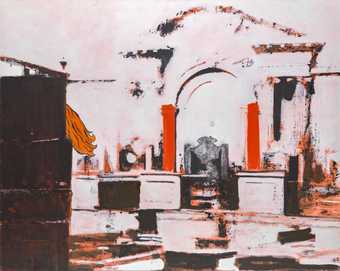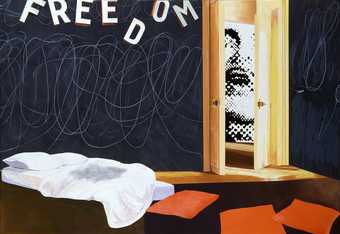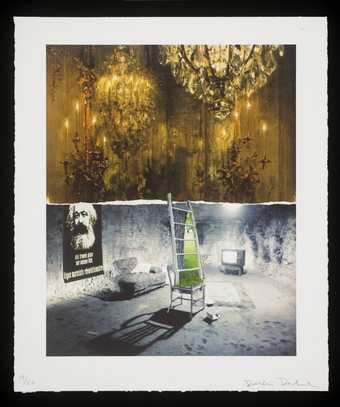In this film British artist Dexter Dalwood talks to us at Tate St Ives, where an exhibition of his work spanning the last 12 years is on show.
Dexter Dalwood's ambitious paintings depict imagined or constructed interiors and landscapes, often drawn from collective memories of historical events, people or places. Dalwood discusses paintings including The Death of David Kelly 2008, based on events following the scandal over 'weapons of mass destruction' in Iraq.
I’m Dexter Dalwood. We’re standing on the side of Porthmeor Beach, in St Ives in Cornwall, just next to Tate St Ives, where my current exhibition of my paintings is on show, works from 1997 to the present day. When I started making paintings, I think, when I was a college and I had some years outside college making pennies, I was always fascinated by the fact that so many artists that I would meet, when you saw their work, they weren’t making work about all the things that they were interested in. And this was always… for me, I always thought, well, why isn’t it possible, in the way that a song writer is, for example, able to write a song, or a group is able to do an album about several things that they are kind of interested in at the time. Why isn’t it possible as an artist to do stuff or do work about everything that you are interested in? And it’s like, encompassing things you read, things you see, things you think about, things you imagine, things you fantasise about. So I think that it took me a long time to work out how to do that.
So these paintings basically were when I started to think about the idea of doing images of rooms and particularly, interiors of places that I’d heard of, but had never actually seen.
This painting is Sharon Tate’s house. This was done literally from a quite detailed description from a book called Helter Skelter, which was a description of the Manson murders, and obviously the murder of Sharon Tate, Roman Polanski's wife. So the thing about this painting was there’s just one descriptive passage in the book where it described when the police first entered the room, all they could see was a couch draped with the American flag, and it wasn’t until they went round to the front of the couch that they found Sharon’s body. And it was just this idea, somehow, of a kind of very strange, early Californian morning that I wanted to get, with a hint of Jasper Johns.
This is Bill Gates’ bedroom. This painting is called Neverland, which is based on some descriptions from the unauthorised biography of Michael Jackson.
And this painting at the end is Hendrix’ last basement. This is kind of the beginning, in a way, of quoting other artists within the painting. And here there’s a Maurice Lewis painting in the bottom half of the canvas.
Collage is a great chance to show lots of images which I have done, and which are not represented by paintings. All these that we see here have become paintings, but not every collage I make does become a painting. I’m not interested in sort of standing in front of a blank canvas and starting off to make a painting. I’m interested in kind of working out what I’m going to do compositionally, and then…but for me, the whole point is how I invent from the graphic of the collage into the painting.
This is the most recent painting, which I’ve actually painted for this exhibition, which is called Mandalay. This painting relates to what, kind of what I’ve been thinking about recently, and a show I did in America that was called Endless Night, which was about a whole series of paintings which were to do with the sort of actual demise, or the untimely death of somebody.
And this painting here, David Kelly, was included in that exhibition, and of course this is a very recent historical subject, because David Kelly is the UN weapons inspector who killed himself, or committed suicide, or there’s a lot of mysterious conspiracy stuff around his death – at the time when he was being questioned about his involvement in the build-up to the Iraq War. I was looking at the date he actually died in July 2003. I’ve researched lunar charts to find out what the moon was like that night, and then find that it wasn’t quite full, it was just off the full moon, and that kind of thing. So those aspects do affect my thinking.
I have people come to the studio sometimes, and they’ll say, ‘Oh yeah, I see you’ve got a bit of Edward Hopper there, and you’ve got – who’s that over there? Is that Bacon?’ As if the painting isn’t in front of them – do you know what I mean? It’s as if, well, okay, yeah, that’s correct, but the painting is the painting, you know, so it’s not… I think some people feel that they have to be… it’s this idea that you have to be clever to understand them, or that I’m trying to wrong-foot you historically – if you don’t get the reference, then you’re kind of thick, or something. But the point isn’t that at all. The point is that why would you get all the references that I’m interested in? There is no generalisation to, you know, I’m interested in… why would I be interested in William Burrows and David Kelly? But, hopefully, it goes beyond that to somehow make people think about, well, I understand why this painting is being made now.



